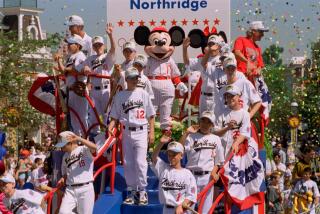EXCHANGING TECHNOLOGY : Team of Local Youths Teaches Soviets How to Play Ball on Tour to East Europe
Whatâs with all these weapons we have pointed at the Soviet Union? In the name of goodwill, only one arm was needed to defeat the Red Army--the lean left arm of John Bushart.
Bushart, a pitcher from Thousand Oaks, turned back the Red Army baseball team, 7-3, during a recent two-week barnstorming tour of the Soviet Union, Finland and Sweden with a team called the Baseball Ambassadors.
The secret?
Pssst. The Soviets canât touch a curve.
Canât do much with a country fastball, either. It didnât take much to figure that out after the first couple of days.
âThey were big and they were great athletes, but they had absolutely no baseball skill,â Bushart said.
Yet what the Soviets lack in fundamentals, they make up for in curiosity and enthusiasm for the American pastime.
âOne of their coaches said they like the game because it reminds them of chess,â Bushart said.
The fundamentals will come, Soviet officials are certain, as long as U.S. teams continue to share the gameâs nuances in the spirit of glasnost. A stream of teams from the United States has made the trip this summer and a collection of minor leaguers from the Eastern League went this month. The Soviets have been playing baseball seriously for three years and their goal is to build a team capable of winning an Olympic medal by the turn of the century. Baseball has been a demonstration sport in the last two Olympics and will be a medal sport at Barcelona, , in 1992.
âI hope the Americans stay champions in this century,â Soviet sports specialist Irakly Kutateladze told the New York Times. âIn the next century, we shall see.â
The Ambassadors, who instructed Soviet players at clinics in debris-strewn warehouses on rainy days and weathered primitive playing facilities, heard the same boast.
â âWe shall see,â â Bushart said, imitating the pet Soviet phrase. âThat was their low-key way of popping off. We heard that before our game with the Red Army. âYou are good players, but we shall see.â â
The Soviets got to see firsthand the array of pitches Bushart, 18, will bring to Cal State Northridge next year as a freshman. In 5 2/3 innings against the Red Army, he struck out 10 and gave up only two hits and two earned runs.
That victory Aug. 8 was the Ambassadorsâ third in as many games against teams from Moscow, first stop on the tour. The team then took a train to Leningrad, defeated the team there, 12-0, then took a bus to Helsinki, Finland, and a cruise ship across the Baltic Sea to Stockholm, Sweden. The only game the Ambassadors lost was a 5-2 decision to the Swedes.
âThe purpose of the tour was to promote peace and good-will,â said Meiers, who has compiled a record of 270-96 during 14 seasons as coach at Arcadia High School. Over the last eight years, Meiers has taken Ambassador teams to Europe, China, Japan, Fiji and Australia.
âI only invite players who are interested in teaching the game to people who have little proficiency,â he said. âThe players have to be talented, so we can demonstrate quality baseball, but possessing quality character is foremost.â
Bushart, who was recommended to Meiers by Thousand Oaks High Coach Jim Hansen, fit the requirements.
âI needed a left-handed pitcher and Iâd heard from scouts that John was real good,â Meiers said. âHis coach assured me that he was the type of person we were looking for. John was a class act all the way.â
Bushart and his teammates, for example, kept their complaints to a minimum when they were served hot dogs, peas and warm cola for breakfast their first morning in Moscow. And their hosts at the Peopleâs Friendship University were âvery friendly, they really worked hard to make our trip the best,â Bushart said. The players stayed five to a room in student dorms at the university.
In 1989, clearly, the Soviets are trying to catch up on the diamond, although most are rough cuts. The nationâs first ballpark, at Moscow State University, was dedicated recently but the Ambassadors played their games on soccer and archery fields at state-run Olympic training facilities. Pitchersâ mounds were nothing more than rubber mats and baselines were drawn with masking tape.
Most of the Soviet players were in their mid-20s and had been recruited from other sports. They then were farmed out to the fledgling baseball teams.
The Ambassadors defeated the Peopleâs Friendship University team, 18-2, and the Moscow University Aeronautics team, 30-3, before beating the Red Army--the best Soviet team--and Leningrad. The Ambassadors, composed mainly of players from Arcadia and San Marino, hit 13 home runs in the first two games.
âOne of the outfielders on the Aeronautics team started playing behind the fence,â Bushart said.
Yet when the Ambassadors began to ease up late in the game, an irate Soviet official complained to Meiers.
âFrom a good-will standpoint we didnât want to embarrass them,â the coach said. âBut they insisted that the game was not interesting if we stopped playing hard. They wanted to see double plays, running catches, hard swings, everything.â
The Soviets obviously considered the play a necessary part of learning a complex game.
âIt blew me away, how much they know already,â Meiers said. âI was unbelievably impressed. Their skills just need to catch up with their knowledge.â
As baseball fever firms its grip, the country is firming its resolve to produce a strong national team. The Soviet Baseball Federation has tripled to 50 teams and 1,500 players in the three years it has fielded teams. This fall, two of the nationâs 28 special youth academies for sports prodigies will be staffed with baseball coaches.
âThe players now will never be the Olympians,â Meiers said. âThese guys are being groomed to be the first crop of coaches.â
Alternate sources of baseball knowledge are available. A pitcher in Leningrad asked Bushart to help him develop a forkball and he obliged. It wasnât the Sovietâs first trick pitch.
âHe threw me a knuckleball and it dropped off the table,â Bushart recalled. âI asked him where he learned it and he said from reading Jim Boutonâs book, âBall Four.â â
Sharing culture came as easily as exchanging pitching tips. Bushart handed out a shoe box full of baseball cards to opposing players and had ample opportunity to barter off the field as well.
Bushart exchanged T-shirts and a pair of old shorts for an authentic soldierâs cap, a Soviet flag, a fur hat and assorted souvenirs.
But the memory of defeating the Red Army team will endure longer than any memento.
âThe first two games, we had no intensity,â he said. âBut for the Red Army game, we were amped. We came out like it was a championship game.â
In the first inning, he struck out the leadoff batter, got the next batter on a comebacker and struck out the No. 3 hitter, an enormous man with a thick beard.
âHe took the most hellacious cut Iâve ever seen on strike 3, a curve down and in,â Bushart said. âI Kâed him (struck him out) three times.â
More to Read
Go beyond the scoreboard
Get the latest on L.A.'s teams in the daily Sports Report newsletter.
You may occasionally receive promotional content from the Los Angeles Times.







